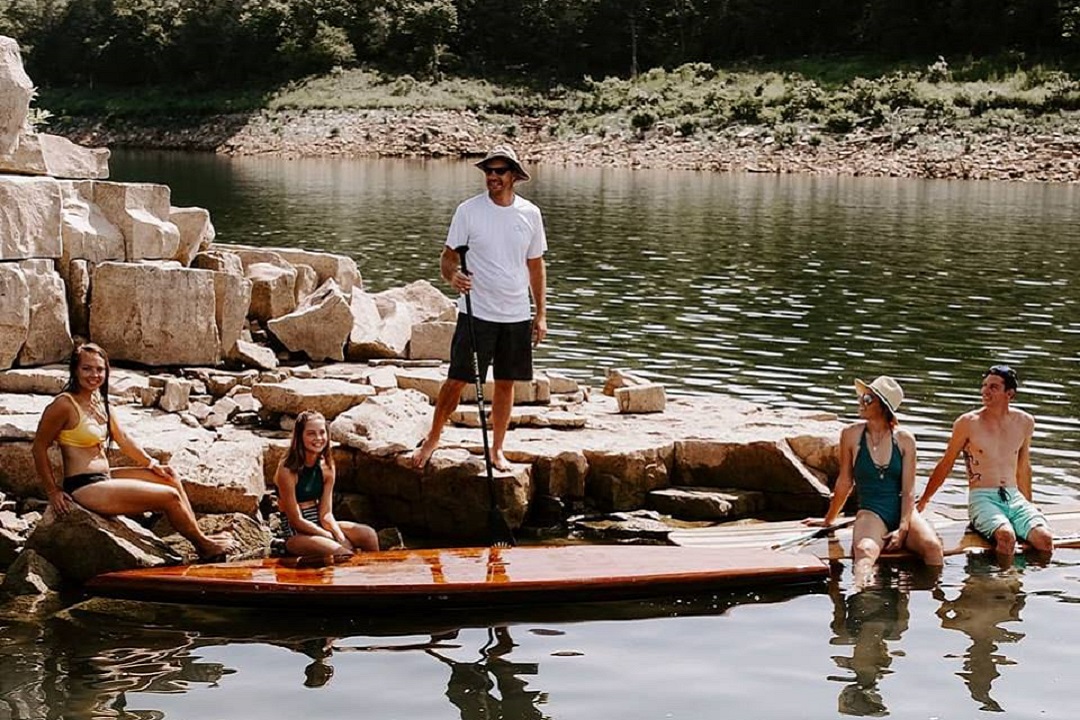Add this to the list of things you might not know about Missouri: the state boasts the best lake in the US for wake surfing. And another: creek surfing is now “a thing” on area waterways.
Those unfamiliar with these activities should know that wake surfing is not the same as wake boarding, where a boat pulls you along. Instead, you ride the endless wave created by a special wake-surfing boat. Table Rock Lake is now considered a nationwide destination for the sport. Creek surfing is done without a boat, usually near a dam that creates the turbulence to make consistent waves.
These surf sports are not for everyone, says Shane Camden, owner of Timber Longboards Co. and a resident of Webster Groves, Missouri. “Wipeouts are pretty hard. Most people quit at about age 45,” he said. For creek surfing, he cautions, “You have to be strong enough to swim in currents.” Camden wears a helmet, wetsuit, and personal flotation device.
Off the water, Camden builds custom stand-up paddleboards and longboards, and more recently, short surfboards. While the majority of his business comes for paddleboards, he’s seen a growing interest in surfboards. He has customers in the Midwest as well as in Southern states including Tennessee, Kentucky, and Florida. His boards can also be found at a surf shop in Florida and at Williams Brothers at Table Rock Lake.
Although Camden started his business four years ago, he made his first hollow-wood paddleboard six years ago. It all started when his wife, Stacy, wanted a stand-up paddleboard, but they were expensive (this was before the inflatable types were available for a few hundred dollars). He said the couple really wanted two paddleboards, so he decided to see if he could make them himself.
Camden had made a surfboard from Styrofoam and fiberglass when he lived in Florida 15 years earlier, but this time he wanted to craft an eye-catching board featuring wood. He is a carpenter by trade and was a homebuilder for many years, so he took his time-honed skills and learned on YouTube how to build a board. He made more over the years and eventually decided to build them full time.
Camden’s boards are made from western red cedar found in Alaska, a strong but lightweight wood that shapes nicely. He uses timber from the center of the tree, so there are no knots. It’s also the most expensive part of the tree.
The core consists of Styrofoam and carbon fiber, overlaid with wood. Fiberglass protects the wood, which is sealed with an epoxy. The result is a handsome, gleaming board that reveals the natural wood grain.

Timber Longboards Shane Camden and is wife, Stacy.
Camden takes great satisfaction in his craft and enjoys the fact that no two boards look alike because of the uniqueness of the grain and embellishments like wood accents in contrasting colors.
Camden’s small wake surfing boards retail for $750. Stand-up boards can range from $1,700 to $3,700, depending on the layers of carbon fiber, use of exotic wood, or difficult contours.
Racers are particularly interested in Camden’s paddleboards, which are light yet sturdy. The biggest local race is the MR340, which starts in Kansas City and works its way along the Missouri River to St. Charles. Three of Camden’s customers are competing this year. Another customer, a young woman in Florida, has won numerous races there.
Camden’s racing boards are generally 20 feet long. The longer the board, the straighter it goes down the river, he said. Shorter boards require more strokes which results in more zigzagging.
“About half of our stand-ups are designed for the Missouri River,” Camden said. “They’re longer and thicker, more buoyant. You don’t want to be out there on a small board. The water swirls, pressure builds up, boils up right under your board. It’s like a whale under you.”
To accommodate growth, this summer Camden is moving his workshop from his basement to a large space in New Haven, a quaint town on the Missouri River.
He will also build canoes, including a 30-footer for 15-person guided tours he will offer. Camden hopes to start a shuttle service along the Missouri River for canoe trips between New Haven, Washington, and Hermann, and he plans to offer canoe-building and paddle-building classes.
He’ll also be keeping his eye on local creek-surfing activity. He said it’s hard to know how much it will grow but said “it could wind up being pretty big in the next couple of years. It’s surfing you can do here in St. Louis. You just show up. You don’t need a $100,000 boat.”
Author: Terri Waters is a contributor to Terrain Magazine.


Leave A Comment